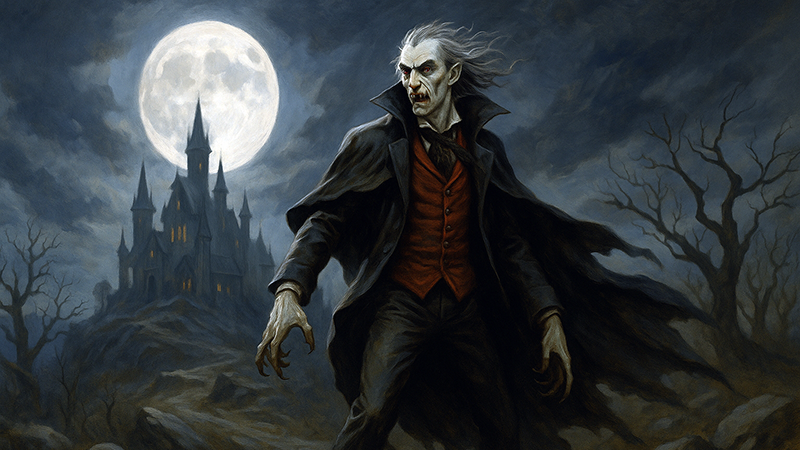Sir Francis Varney—the verbose, brooding, and strangely sympathetic vampire at the heart of the Victorian penny dreadful Varney the Vampire; or, The Feast of Blood (1845–1847)—was there before Dracula or Barnabas Collins. Published in serialized form and attributed to James Malcolm Rymer (and possibly Thomas Peckett Prest), the story spans hundreds of chapters and over 800 pages, often drifting in tone, but it laid the foundation for nearly every vampire trope that would follow.
Origins and Publication
Varney the Vampire was originally released in cheap weekly installments targeted at working-class readers hungry for thrills. Like other penny dreadfuls, it was melodramatic, sprawling and filled with cliffhangers designed to keep readers coming back for more. The story is set in early 18th-century England and follows the Bannerworth family, who are plagued by a mysterious figure—Sir Francis Varney—who appears to be a vampire.
Though inconsistencies and contradictions abound (a symptom of serialized writing), the influence of the work is unmistakable: it introduced the concept of puncture wounds in the neck, hypnotic influence and the conflicted, tragic vampire longing for release.
Character Profile: Sir Francis Varney

Sir Francis is no caped predator. He’s tall, gaunt, well-spoken and aristocratic—a nobleman with a curse. Throughout the novel, Varney is portrayed with surprising nuance. At times he’s terrifying, at others pitiable. He loathes his condition, frequently speaks of his suffering and even attempts suicide multiple times. Unlike later vampires like Dracula who embrace their power, Varney is tormented by it.
He is haunted by remorse and isolation. In one chapter, he laments: “I am a dreaded, a hated thing. A vampire! Who could love me—what being, with a soul, would not shrink from me in horror?”
That line, and others like it, elevate Varney above simple villainy. He’s a monster who recognizes the truth about himself, and that tragic awareness makes him one of the first truly conflicted vampires in literature.
Gothic scholar Danel Olson once observed, “Varney is a muddled, contradictory character, but in that mess lies his modernity—he’s the prototype for the tortured antihero who longs to transcend the monstrous.”
Tropes Introduced by Varney

Varney predates Dracula by over 50 years and Carmilla by nearly three decades. Many of the conventions readers associate with later vampire fiction appeared first in his story: fang marks on the neck, hypnotic powers of persuasion, vampirism as a curse rather than a choice, the vampire as romantic or tragic figure and fear of hereditary curses and gothic family trauma.
Notably, while he drinks blood, Varney the Vampire never firmly codifies how his vampirism “works.” Sometimes he behaves like a ghost, other times like a zombie and occasionally like a full-on Nosferatu. That lack of consistency has frustrated critics but also makes him a unique prototype for later reinventions.
As horror author David J. Skal once quipped in an interview: “If Dracula is the symphony, Varney is the jam session—it’s rough, it rambles, but it hits some unforgettable notes first.”
Reprints, Reappraisals, and Legacy
Despite its meandering plot and uneven tone, Varney the Vampire had staying power. It was eventually collected into a single (massive) volume, and in the 20th and 21st centuries, scholars and horror enthusiasts have come to recognize it as essential to the vampire canon.
Modern writer and historian Kim Newman, whose Anno Dracula series includes Varney, called him “the missing link between Lord Ruthven and Dracula… a literary bridge between cruelty and conscience.”
Final Thoughts
Sir Francis Varney may not have the pop-culture clout of Dracula or the queer complexity of Carmilla, but he is their literary ancestor. He is the first vampire to truly wrestle with what he has become, making him less a monster to be feared and more a man to be pitied. His is a long, tortured un-life of regret—the original reluctant vampire. And in a genre that thrives on emotional torment and immortal longing, Varney is where it all began.
